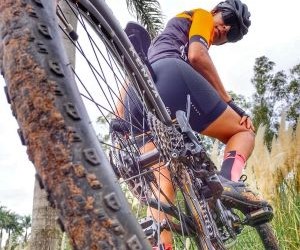Learn how to deal with punctures on long rides with prevention tips, repair techniques, and smart gear choices to keep rolling without stress.
HOW DO I PREVENT BACK PAIN WHILE CYCLING?
Back pain can be a real buzzkill for cyclists, whether you're a casual weekend rider or a dedicated road warrior. The good news? Most cycling-related back pain is preventable with the right bike fit, posture, and conditioning. In this guide, we'll unpack why cycling can cause back pain, how to prevent it through practical changes, and what to do if it starts creeping in during your rides. From bike setup to muscle strength and mobility, we’re covering it all to keep your spine happy.

Why cyclists experience back pain
Cycling is often touted as a low-impact sport, but many riders—especially those logging serious mileage—experience back pain. This discomfort typically stems from prolonged time in a fixed, flexed posture. Over time, poor mechanics, improper bike setup, and muscular imbalances exacerbate spinal stress.
Common causes of cycling-related back pain
Poor bike fit: A saddle that's too high or low, or handlebars set too far forward, forces unnatural spine angles.
Weak core: Without solid core strength, your back takes on more of the load.
Limited mobility: Tight hamstrings, hips, and lower back restrict efficient movement and strain the lumbar region.
Overtraining: Long hours in the saddle without proper recovery can inflame spinal joints and muscles.
Poor posture habits: Slouching or excessive arching accumulates stress over time.
It’s a biomechanical problem, not just a bike problem. Think of your bike as a custom tool—if it's not dialed in for your body, it’ll work against you. Understanding where your pain originates is step one. From there, you can adjust your setup, training, and mobility work accordingly.
What makes cycling unique is its static posture. Unlike running, you’re not rotating or moving your spine significantly. So any misalignment sticks around for the entire ride. That repetition is both a blessing and a curse—great for endurance, rough on your back if you’re out of whack.
The key is to balance the strength you need with the mobility you lack, all while refining your riding posture and equipment setup to match your anatomy.
Optimizing bike fit to protect your spine
Bike fit isn’t just for elite cyclists—it’s the single most important factor in preventing back pain. An improperly fitted bike can force awkward positions, strain muscles, and compress your spine over long distances. A proper fit aligns your body so power transfers efficiently and comfortably.
Essential adjustments to prevent back pain
Saddle height: Ensure your knee has a slight bend at the bottom of the pedal stroke to avoid overextending the leg and pulling the pelvis forward.
Saddle tilt: Keep the saddle level or with a slight nose-down tilt. Too much tilt leads to sliding forward and rounding the back.
Handlebar reach and drop: A shorter reach reduces spinal flexion, while a higher handlebar position minimizes excessive lower back strain.
Crank length: Shorter cranks can reduce hip flexion and back rounding for shorter or less flexible riders.
Cleat position: Poor foot alignment affects knee and hip tracking, which can subtly impact your lumbar spine.
Getting a professional bike fit can save you years of discomfort. Fitters assess your flexibility, riding goals, and biomechanics, then tweak components to minimize strain. For example, riders with tight hamstrings may need a more upright posture to avoid posterior chain stress.
DIY fit adjustments can help too. Film yourself from the side while riding on a trainer. Your back should be relatively flat, not overly rounded or arched. If your elbows lock out or your neck cranes, you’re too stretched.
Also, check your gear. A heavily loaded backpack, stiff cycling shoes, or a too-narrow saddle can subtly affect your posture. Comfort comes from cumulative micro-adjustments—optimize them all.
Ultimately, bike fit is about making your ride as ergonomic as your office chair should be—tailored, supported, and optimized for endurance.
Training smart to support your spine
Even with perfect bike fit, a weak or imbalanced body will still struggle to avoid pain. The spine depends on surrounding musculature—especially the core, glutes, and hips—to stay supported through long efforts. A smart training program builds the strength and mobility you need to ride pain-free.
Key strategies to train for a pain-free back
Core conditioning: Exercises like planks, bird-dogs, and dead bugs build the deep stability your spine relies on.
Hip mobility: Tight hips alter pelvis position and strain the lumbar spine—add hip flexor stretches, 90/90s, and pigeon pose to your routine.
Posterior chain strength: Deadlifts, glute bridges, and hamstring curls balance your muscle usage on the bike.
Spinal mobility: Thoracic extensions and cat-cow flows counteract excessive flexion from riding posture.
Recovery protocols: Foam rolling, massage, and active rest days allow tissue repair and prevent overuse injuries.
Training off the bike matters just as much as on-bike mileage. A weak core leads to sloppy posture, which leads to pain. Integrating 15–20 minutes of mobility and strength work 3–4 times per week can yield massive results in comfort and efficiency.
Also consider your riding volume. Progressive overload is key—don’t jump from weekend rides to century weeks overnight. Increase total mileage by no more than 10% weekly, and pay attention to early signs of fatigue or soreness in your lower back.
Finally, check in with your posture during long rides. Use natural landmarks—every time you pass a stoplight or hit a new mile marker, run a mental scan: Are your shoulders relaxed? Is your core engaged? Are you hinging from the hips rather than curving the spine?
Consistency trumps intensity here. Sustainable routines prevent chronic pain. Train for strength, train for balance, and the back pain will stay in your rearview.
YOU MAY ALSO BE INTERESTED






